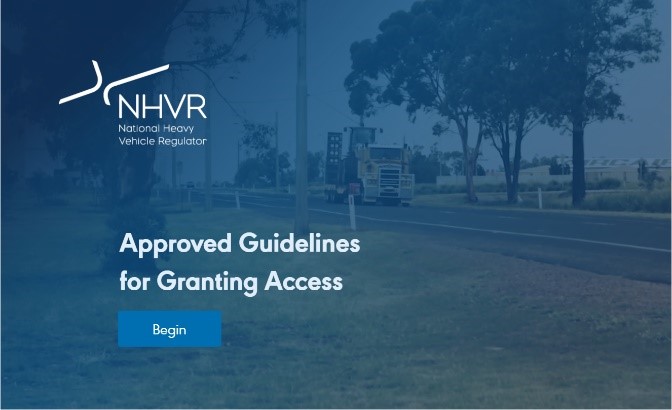On this page:
The Heavy Vehicle National Law (HVNL) is applicable in all states and territories except Western Australia and the Northern Territory.
The HVNL provides that certain classes of heavy vehicles (restricted access vehicles), despite being registered and compliant with the HVNL and other legal requirements, may only be used on a public road if the operator has been granted access through a notice or permit (mass or dimension authority) from the National Heavy Vehicle Regulator (NHVR). Restricted access vehicles are subject to restrictions to ensure that the use of these vehicles does not endanger public safety, and to minimise or avoid any adverse impact on road infrastructure and public amenity.
The Approved Guidelines for Granting Access contains high-level guidance and clarity on aspects of heavy vehicle access decision making under the HVNL. The HVNL requires that road managers, road authorities and the NHVR must 'have regard to' these guidelines. Ministerial consent is required to amend these guidelines.
Approved Guidelines for Granting Access (PDF, 795KB)
eLearning Module
The NHVR has developed an eLearning module to assist road managers and the heavy vehicle industry in understanding the Approved Guidelines for Granting Access.
Please allow for up to 45 minutes to complete the course.
What are the different levels of access?
Authorised networks
An authorised network is a notice with a published network of roads that identify where various vehicle categories can drive without a permit, provided they meet specific requirements.
The NHVR encourages road managers to provide consent to a notice for common vehicle types and routes. We consults with all affected road managers to gain consent for each notice. Approving a notice reduces the administrative burden for local government and promotes industry productivity and efficiency. Unlike permits, notices follow a different process than permits and are developed outside NHVR Go.
For more information, see Network access.
Pre-approvals
When the NHVR receives a permit application for movement on a local road that is pre-approved by the relevant road manager for the vehicle type, the NHVR does not need to seek additional consent from the road manager before issuing a permit. The NHVR will supply a copy of the permit to the road manager.
The NHVR works extensively with local government road managers to gain pre-approved consent for a range of routes. This process targets routes expected to experience large numbers of vehicle movements, such as roads in industrial areas and access routes connecting existing approved routes or State-controlled roads (road authority owned roads).
For more information, see Pre-approvals.
Permits
A permit authorises a specific vehicle/s to use part of the road system (potentially subject to conditions). Permit requests are received through NHVR Go.
NHVR Go is a web-based entry point for operators to apply for permits and for road managers to provide consent.
For more information, see Access permits.
Identifying and managing risk
Step 1: Identify risk
The road manager should evaluate the likely impact of the heavy vehicle on road infrastructure, community, and public safety.
When a risk is identified, it must comply with the specific requirements laid out in section 156A of the HVNL and relevant guidelines.
The mass or dimension authority will, or is likely to—
- cause damage to road infrastructure; or
- impose adverse effects on the community arising from noise, emissions or traffic congestion or from other matters stated in approved guidelines; or
- pose significant risks to public safety arising from heavy vehicle use that is incompatible with road infrastructure or traffic conditions
Step 2: Consider Risk Mitigation
Risk mitigation involves the process of identifying, assessing, and controlling risks associated with granting a heavy vehicle access permit. The goal is to minimize the negative impact of these risks, and to make the process of granting permits more streamlined, predictable, and safe.
Road managers have several tools at their disposal for risk mitigation during the assessment of access permit applications:
- Imposing Conditions: Where road managers hold concerns about providing access because of one or more relevant risks, the road manager is required by the HVNL to consider imposing conditions to avoid or significantly minimise the impacts linked to a granting of access. These conditions aim to control risks related to traffic congestion, safety hazards, noise pollution, or environmental damage.
- Restricting Permit Duration: If there are concerns that the effects of heavy vehicle access might change over time (e.g., road conditions might deteriorate), a road manager can restrict the duration of the permit. This allows for more frequent reassessment of the access request.
- Restricting Permit Trips: Road managers can control the frequency of potential impact by limiting the number of approved trips on a permit. This can be helpful where there are concerns about cumulative impacts on road infrastructure, public safety or community amenity.
- Restricting Mass: Under the HVNL, if a road manager believes that reducing the vehicle's mass could successfully mitigate a potential risk, they must consent but add a road condition stipulating the vehicle must not exceed the newly determined mass. This is a method that can help protect road infrastructure from damage.
These risk mitigation strategies provide a flexible approach to managing the needs of the operators while prioritising the safety and integrity of the infrastructure and community.
Step 3: Consider alternate routes
When a road manager identifies a particular section of a requested route where heavy vehicle access is not possible, road managers are encouraged to investigate the option of an alternative route to assist the operator in obtaining access.
For detailed information of the requirements and process for proposing a valid alternate route see the Road manager - proposing an alternate route.
Step 4: Evaluate Feasibility
If it's not feasible to mitigate the effects through conditions and/or permit restrictions, and there is no alternative route available, the road manager may decide not to give consent. This decision should only be made after careful consideration of all potential risks and the possible ways to mitigate them.
The decision-making process should be thorough, ensuring all potential impacts are considered, and all possibilities for mitigation are explored.
For information on valid refusals, please visit Road manager - processing refusals under the HVNL.
Contact us
Local government road managers can contact the NHVR for assistance by emailing info@nhvr.gov.au.
Once your email has been received and reviewed, an NHVR staff member will call you as soon as possible to assist you with your enquiry. Should you deem your request to be urgent please contact us at 13 NHVR (13 64 87) to speak to the NHVR Contact Centre.
More information on how to action your role or get support can be found on our Training and support page.

 Accessibility tools
Accessibility tools


